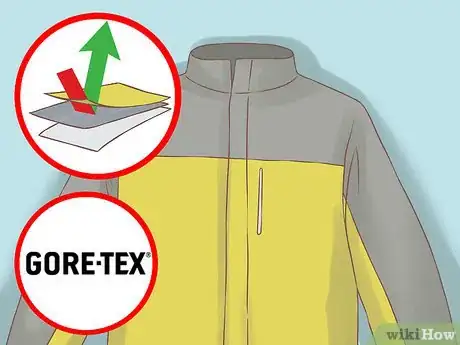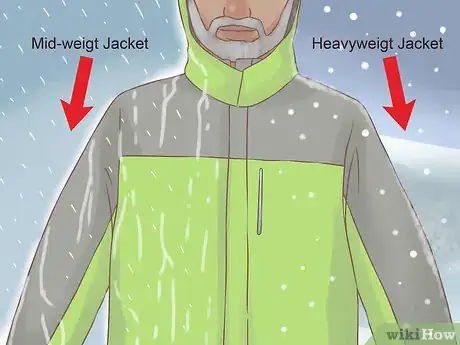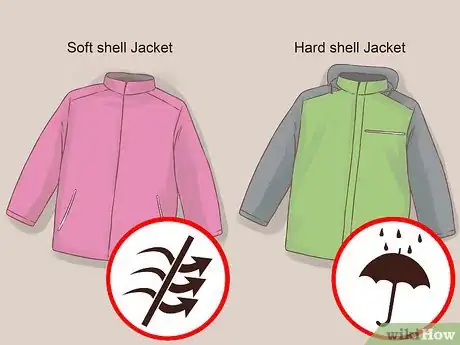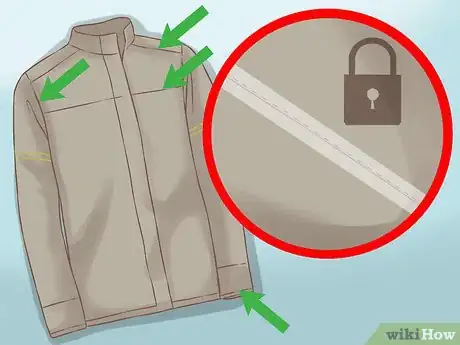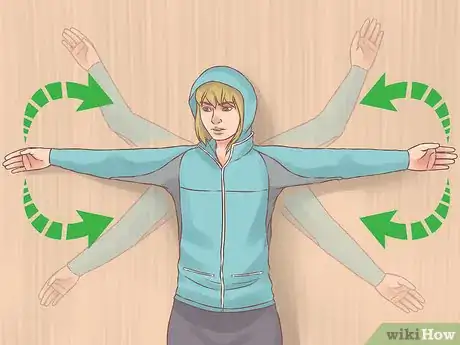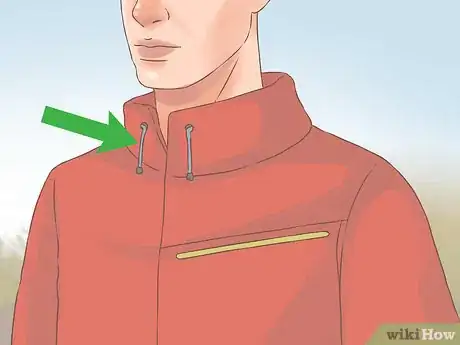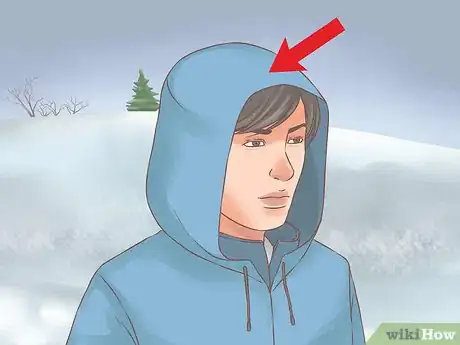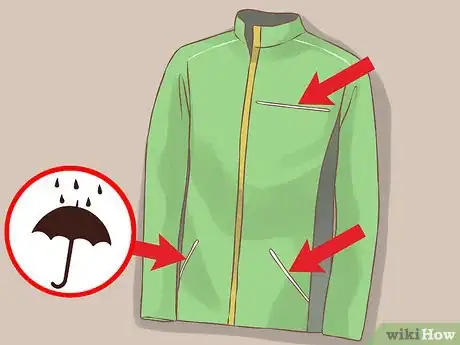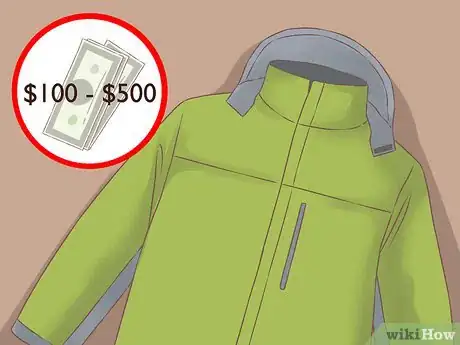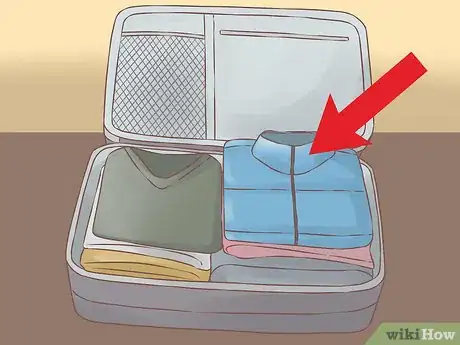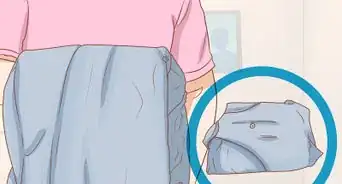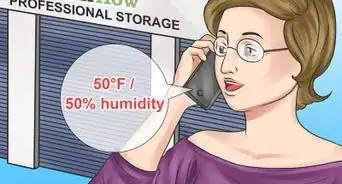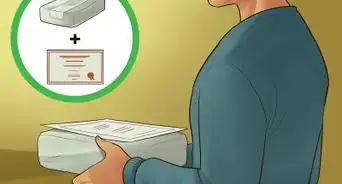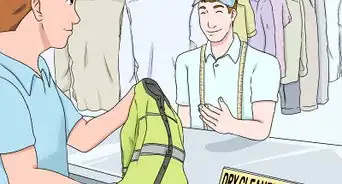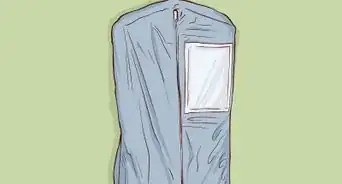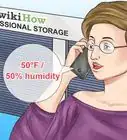X
wikiHow is a “wiki,” similar to Wikipedia, which means that many of our articles are co-written by multiple authors. To create this article, 16 people, some anonymous, worked to edit and improve it over time.
This article has been viewed 57,166 times.
Learn more...
Anyone who enjoys spending a great deal of time outdoors should invest in a waterproof jacket. Waterproof jackets block out rain and other precipitation, keeping your clothes and skin dry. Some jackets are better suited for certain activities, and come in a variety of protection levels. It is important to familiarize yourself with the options and features available beforehand, so you can make the an educated decision based on your specific needs.
Steps
Part 1
Part 1 of 2:
Choosing a Style
-
1Distinguish between water resistant and waterproof. Waterproof jackets are made with a waterproof membrane woven directly into the jacket. They allow small perspiration droplets to leave your body while keeping larger water droplets out, making them breathable. Water resistant jackets have no membrane, but are treated with a water repellent material designed to keep water droplets from seeping through the jacket.[1]
- Waterproof jackets have all of their seams taped or otherwise covered to make sure moisture doesn’t penetrate the jacket via stitching.
- Water resistant jackets will keep out most moisture, but cannot withstand heavy downpour or being submerged in water. The absence of a waterproof membrane makes them cheaper than the waterproof option.
- Typically the tags on these jackets will indicate whether it is water resistant or waterproof.
-
2Consider breathability. Waterproof jackets come in a variety of different breathability levels. The level of breathability you need depends on the activity level you’re planning to use it for.
- For physically intense activities like hiking, biking, or running you’ll need a jacket with high breathability. Look for jackets with a special membrane layer that allows small water molecules, in the form of sweat, to pass through, while trapping large raindrops on the outside.[2]
- For less strenuous activities like walking the dog or everyday use, a less breathable jacket that is more water resistant will work fine.
Advertisement -
3Look at the layers. There are different layer options for waterproof jackets. 3 layer jackets (3L) have all their layers, including the lining fused together, which make for durable snow jackets. 2 layer (2L) jackets have a separated fabric lining which makes them bulkier. 2.5 layer jackets have a raised pattern on the interior designed to keep the material up off your skin.
- 2.5 layer jackets are usually designed to protect against very light rain.[3]
-
4Opt for membrane laminate or coated. Waterproof jackets come with varying types of membrane laminates such as GORE-TEX®, Marmot's MemBrain® (Polyurethane) and SympaTex (Polyester). Coated fabrics are highly waterproof, but are less breathable than membrane laminates. They are cheaper and usually thicker than membrane laminated jackets, and are perfect for keeping you warm and dry in activities that require minimal physical exertion.[4]
- If you need a durable jacket for snow you’ll want a 2 layer or 3 layer laminated fabric.
-
5Choose between lightweight, mid-weight, and heavyweight options. Lightweight jackets are great for people who don’t need to wear them for extended periods of time, or in heavy downpours. If you’re going to spend the entire day out in persistent rain, look for a mid-weight jacket. If you’re planning to be out in cold, wet weather, a heavier jacket will offer more protection against the elements.
- Keep in mind, a jacket that is too heavy might be difficult to move around in.
-
6Pick a soft shell or hard shell jacket. Most soft shell jackets are like windbreakers and fall under the water-resistant category. They are very breathable and generally warmer, keeping you dry during light showers, mists, and snow, but leave you drenched after a downpour. Hard-shell jackets are usually windproof and have the waterproof coatings that are designed to keep you dry in the rain. They typically come with a hood and are more expensive, and less breathable.[5]
-
7Select fully taped or critically taped seams. Seam taping or sealing is the application of a thin waterproof tape over the tiny holes left behind by the needle used to sew the jacket together. Jackets come either fully taped, or critically taped.
- Fully taped means every single seam has been taped to prevent leaks.
- Critically taped means only the high exposure areas of the jacket like neck, shoulders, and chest have been taped.
- If your jacket is inadequately sealed, you will get wet, even in the best waterproof jacket.[6]
Advertisement
Part 2
Part 2 of 2:
Looking for Specific Features
-
1Find the proper fit. Once you narrow down what kind of jacket you need or want, you need to make sure it fits correctly. A waterproof jacket should fit snugly without restricting your movement. When trying one on, move around: jump up and down, wave your arms around, and twist your body. You want to make sure you have full range of movement available to you.
- Make sure it’s big enough to fit two layers of clothing underneath, long enough that it never exposes your midsection, but not long enough to restrict movement.[7]
-
2Choose one with draw-cords. They can be used to make sure your jacket fits as perfectly as possible. They’re usually located at the bottom and waist of the jacket, as well as on the sides.[8]
-
3Look for a hooded jacket. Because we lose most of our heat through our heads, a jacket with a hood that fits properly is crucial. Most jackets are equipped with adjustable hoods, make sure the hood moves with your head while keeping it covered.[9]
-
4Check the zips. Make sure all zips run smooth the entire length of the zipper and that the main one is easy to fasten at the bottom. If the zips are not waterproof, make sure they have storm flaps that will prevent water from getting in. You’ll also want to check that the jacket has pit zips if you’re planning to use it for physical activities, as they help with ventilation to keep you from overheating.[10]
-
5Think of the pockets. Pockets are a convenient feature to have, how many pockets you need on your waterproof jacket depends on how you plan to use it. Make sure the jacket has enough for your needs and that the outside pocket zips are either waterproof or protected by storm flaps to keep moisture out.[11]
-
6Search for jackets with mesh-lined pockets. Mesh-lined pockets provide the added convenience of extra ventilation, making it easier for sweat to evaporate away during physical activity.
-
7Pick a price point. How much do you want to spend on a water proof jacket? In general, jackets with superior waterproofing are going to be more expensive, around $100+ more than less advanced jackets.[12]
- If the prices of full waterproof jackets seem a bit too steep for you and your needs, jackets with just a waterproof coating might be the way to go. They are just as effective at keeping the rain out, but they do tend to lack in the breathability category.
- Many reputable manufacturers like The North Face and Patagonia sell waterproof jackets that are durable enough to last you for years for around $100-$150. This may be a good option for those wanting a light to mid-weight jacket.
- If you’re buying one for extended intense exercise or activities, a cheap poorly-constructed jacket will not provide the necessary protection. Make sure you get the level of protection you need, and know that full-featured jackets can end up being a $600 investment.[13]
-
8Think about storage. Light weight water resistant jackets can be easily folded or rolled up to pack away nicely. You may want to consider how you will store or pack your more durable waterproof jacket, if it can't be easily folded or made compact for traveling. This is especially important if you purchase a heavy weight, full featured waterproof jacket that is too bulky to fold.
Advertisement
References
- ↑ http://theydiffer.com/difference-between-waterproof-and-water-resistant-jackets/
- ↑ http://www.ebay.com/gds/Experts-Guide-to-Buying-a-Rain-Jacket-that-works-/10000000177699564/g.html
- ↑ http://www.evo.com/guides/outerwear-waterproof-ratings-and-breathability
- ↑ http://www.evo.com/guides/outerwear-waterproof-ratings-and-breathability
- ↑ http://sectionhiker.com/what-is-the-difference-between-a-hard-shell-jacket-and-a-softshell-jacket/
- ↑ http://www.evo.com/guides/outerwear-waterproof-ratings-and-breathability
- ↑ http://www.gooutdoors.co.uk/expert-advice/waterproof-jackets-guide
- ↑ http://www.gooutdoors.co.uk/expert-advice/waterproof-jackets-guide
- ↑ http://www.gooutdoors.co.uk/expert-advice/waterproof-jackets-guide
- ↑ http://www.gooutdoors.co.uk/expert-advice/waterproof-jackets-guide
- ↑ http://www.gooutdoors.co.uk/expert-advice/waterproof-jackets-guide
- ↑ http://www.ebay.com/gds/Experts-Guide-to-Buying-a-Rain-Jacket-that-works-/10000000177699564/g.html
- ↑ http://www.ebay.com/gds/Experts-Guide-to-Buying-a-Rain-Jacket-that-works-/10000000177699564/g.html
About This Article
Advertisement



